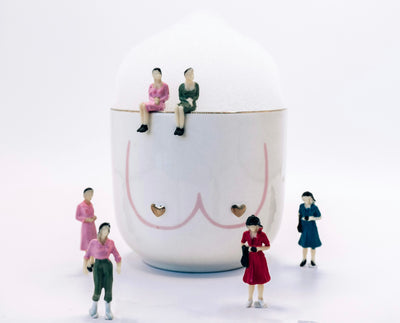10 Breastfeeding Tips Every Mom Should Know
10 Breastfeeding Tips Every Mom Should Know
by Dr. Stephanie Canale - founder of Lactation Lab
My practice at UCLA is largely made up of new moms and babies. I also see a lot of soon-to-be moms and have now made it a point to discuss nursing during pregnancy, versus waiting until the baby is here. I recommend to everyone that they take a breastfeeding class before their baby arrives—even 2nd or 3rd time moms—because every baby is different and sometimes a refresher is helpful! I also tell all expectant moms that many women find nursing more difficult than labor and delivery!
With new moms, I often try to watch mom feed during our first few visits. I make sure to acknowledge how difficult it is and how wonderfully they are doing. With both of my children I struggled to breastfeed, and I know that sometimes a few cheers and helpful hints can go a long way.
Here are my top ten tips for nursing moms, gathered over the years from seeing patients and my own breastfeeding journey.
TIP #1:
For most women, breastfeeding is not easy! If this is your experience you are not alone. Engorgement, mastitis, clogged ducts and bleeding nipples are common — and treatable! Depending on the situation and their level of breastfeeding expertise, your OB or pediatrician may be able to help. If not, find a local lactation consultant. They will come to your home, observe you and baby during a feeding session, and be able to help you both learn this new skill. While visits can be pricey, some will take insurance so don’t be afraid to call and ask!
TIP #2:
It’s very normal if at first you don’t find nursing enjoyable. You’re feeding around the clock, and may also be pumping or supplementing with a bottle, which can make it feel as if you never get a break. Plus, many mothers report being anxious about their supply and baby’s weight gain and the bond that comes from nursing may take time to establish. It is common for mothers to only start to enjoy nursing once their babies are 2-3 months old.
TIP #3:
Pumping may be helpful for moms who are anxious about their supply and want to see exactly how much milk their babies are getting, particularly if their child is underweight. (If you’d prefer to exclusively nurse, there are scales you can buy for home that can tell you how much baby has gained during a feeding.) It’s also key for giving you a break as it allows someone else to handle the occasional feed. This can be great baby bonding time for dad or another family member!
TIP #4:
Be patient. What works for one mom may not work for you. Be open to trying different nursing positions for you and your baby ( e.g., straddle or laid-back) and understand it may take time. Again, a lactation consultant can be a great resource during this time!
TIP #5:
Fun fact: Almost 75% of women produce more milk from one breast than the other and it’s more commonly the right breast. You likely will notice this either because you’re pumping and your output is clearly larger on one side or because your baby tends to spend more time on one breast than the other. There are ways to improve milk supply, but generally there’s no need to be concerned if you see more volume from one breast than another.
Tip #6:
Prenatal and postnatal vitamins may not provide all of the nutrition your baby needs. For this reason, it’s important to eat a varied and healthy diet and to ensure you’re drinking enough liquid. If you want to be sure of your milk’s nutritional content, consider having it tested.
Tip #7:
All breastfed babies should be receiving a vitamin D supplement in the amount of 400 IU daily. Your pediatrician will likely mention this to you at one of your early visits, but the CDC recommends beginning supplementation as soon as you bring your baby home from the hospital. There are many different brands that make a liquid version that is usually well tolerated. Unless your pediatrician advises otherwise, choose a supplement that provides vitamin D only.
Tip #8:
If your baby is fussy, try eating a low FODMAP (Fermentable, Oligosaccharides, Disaccharides, Monosaccharides and Polyols) diet. This means eliminating most dairy and beans (among other foods) and focusing on meats, grains, fruits and vegetables. Anything that can help with gas, fussiness and irritability, which in turn could potentially result in more sleep, is worth a try!
Tip #9:
You can burn over 1,000 calories a day just by breastfeeding! Translation: this is not the time to go on a diet and cut calories! Instead, focus on eating healthy foods that will nourish you and your baby. Because it can be hard to find time to shop and meal prep with a newborn, it can be helpful to have nourishing prepared or packaged foods on hand so you can snack as needed.
Tip #10:
You do you. There can be a culture of judgment surrounding a woman’s choices about how she feeds her baby. Don’t buy into it. Do whatever works for you and enjoy your baby! Whether it be bottle feeding, breastfeeding, pumping or nursing, all that matters is your baby is healthy and so are you! Motherhood has enough challenges — let’s eliminate the stress associated with feeding your baby.
So there you have it–my top ten tips for any breastfeeding mom. If you want more information and support backed by research and personal experience, consider subscribing to Lactation Lab’s newsletter, or download the Emily’s Care app to access the virtual lactation consultant and have your breastfeeding related questions answered.
About Dr. Canale: Stephanie is a tireless advocate of maternal and infant health. She is a practicing family physician at UCLA Santa Monica and the founder of Lactation Lab.
A version of this post originally appeared on mamasuncut.com.






